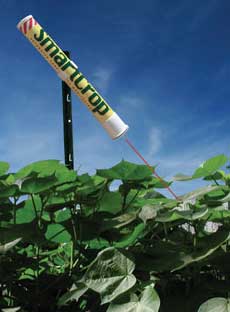Washington, DC
April 29, 2008Plants
text message farmers when thirsty
ARS News Service
Agricultural Research Service, USDA
By
Don Comis
Beginning this crop season,
farmers will be able to receive text messages on their cell
phones from their plants saying whether they are thirsty or not.
 |
|
An automated
infrared sensor system tells farmers when plants
are thirsty or hotter than their ideal growing
temperature and need cooling off with irrigation
water.
Un sistema automatizado de sensores infrarrojos
indican a los granjeros cuando las plantas
tienen sed o sufren del estrés de calor y
necesitan refrescamiento con agua de riego.
Photo courtesy of SmartCrop. |
|
Accent Engineering, Inc., of
Lubbock, Tex., developed the
SmartCrop™ automated drought monitoring system based on a
patent held by the
Agricultural Research Service (ARS). They are offering it
for sale in time for this growing season.
Battery-operated infrared
thermometers placed in irrigated fields monitor leaf
temperatures and relay that information to a computerized base
station. A cell phone modem can be hooked up to the base station
to download data to a personal computer. This modem can also
send text messages to a farmer's cell phone.
ARS plant physiologist
James Mahan at the ARS
Plant Stress and Germplasm Development Research Unit in
Lubbock is one of the original theorists of the idea behind
SmartCropTM. Each plant species has a fairly narrow range of
internal temperatures it prefers for best growth. When leaf
temperature goes above the upper limit or threshold of that
range for too long, the plant needs water, as much for cooling
down as to quench its thirst.
In the Texas High Plains area,
for example, Mahan found that cotton begins to suffer from
drought if cotton plant leaves stay above 82 degrees Fahrenheit
for more than 6-1/2 hours. Farmers can choose the
time-temperature threshold at which they would like to receive
an alert, and adjust it at any time.
ARS is the
U.S. Department of Agriculture's
chief scientific research agency.
Comenzando en esta época de
cultivación, los granjeros podrán recibir mensajes de texto en
sus teléfonos celulares enviados por las plantas para indicar si
tienen sed o no.
Comenzando en esta época de
cultivación, los granjeros podrán recibir mensajes de texto en
sus teléfonos celulares enviados por las plantas para indicar si
tienen sed o no.
La compañía Accent Engineering,
Inc. de Lubbock, Texas, desarrolló el sistema automatizado
llamado SmartCrop™ para
monitorear la sequía. El sistema es basado en tecnología
desarrollada y patentada por el
Servicio de Investigación
Agrícola (ARS). La compañía está vendiendo el sistema a
tiempo para esta época de cultivación.
Con este sistema, algunos
termómetros infrarrojos operados con baterías y colocados en los
campos regados monitorean las temperaturas de las hojas de
plantas y transmiten esa información a una estación base
computerizada. Un modem de teléfono celular se puede conectar a
la estación base para bajar datos a una computadora personal.
Este modem también puede enviar mensajes de texto al teléfono
celular del granjero.
El fisiólogo de plantas
James Mahan, quien trabaja en la
Unidad de Investigación del Estrés de Plantas y el Desarrollo de
Germoplasma mantenida por ARS en Lubbock, es uno de los
constructores originales de la idea detrás de SmartCrop. Cada
especie de planta tiene una gama relativamente estrecha de
temperaturas internas que la planta prefiere para el crecimiento
óptimo. Cuando las temperaturas de las hojas sobrepasan el
límite superior o el umbral de esa gama por mucho tiempo, las
plantas necesitan agua para refrescarse y para saciar su sed.
En el área de las llanuras
altas de Texas, por ejemplo, Mahan descubrió que el algodón
comienza a sufrir de la sequía si las hojas de la planta de
algodón se mantienen sobre 82 grados Fahrenheit por más de 6
horas y medio. Los granjeros pueden escoger el umbral de tiempo
y temperatura que causan que ellos reciban una alarma, y
ajustarlo en cualquier momento.
ARS es la agencia principal
de investigaciones científicas del
Departamento de Agricultura de
EE.UU. |